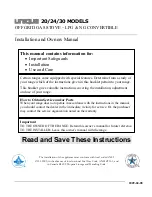
8
Operating Instructions and Owner’s Manual
Grand Teton Wood Pellet Fire Stove
INSTALLATION
CONTACT INFORMATION
If you have any questions regarding ventilation options
of your stove, contact either:
The manufacturer Mr. Heater Company at
1-866-
740-2497
•
Weekends/After Hours 423-488-6316 •
grandtetoncollection.com. Our office hours are 8:00
AM – 5:00 PM, EST, Monday through Friday.
The National Fire Protection Association (NFPA) and
request a copy of the latest editions of NFPA Standard
211. The mailing address of the NFPA is Batterymarch
Park, Quincy, MA 02269.
WARNING: WHEN THIS STOVE IS NOT
PROPERLY INSTALLED, A HOUSE FIRE MAY
RESULT. TO REDUCE THE RISK OF FIRE,
FOLLOW THE INSTALLATION INSTRUCTIONS.
CONTACT LOCAL BUILDING OR FIRE
OFFICIALS ABOUT RESTRICTIONS AND
INSTALLATION INSPECTION REQUIREMENTS
IN YOUR AREA.
CAUTION: ANY DEVIATION OR ALTERATION
FROM THESE INSTALLATION INSTRUCTIONS
MAY RESULT IN DAMAGE TO YOU, THE
STOVE, YOUR CHIMNEY, AND YOUR HOME.
YOUR WARRANTY MAY BECOME VOID. READ
AND FOLLOW ALL INSTRUCTIONS. Contact
Mr. Heater with any comments, concerns, or
questions.
CAUTION: CONTACT LOCAL BUILDING OR
FIRE OFFICIALS ABOUT RESTRICTIONS AND
INSTALLATION INSPECTION REQUIREMENTS
IN YOUR AREA.
PLANNING
Make sure that you have selected the correct stove
for your heating requirements by checking the
specifications table on page 3.
Take measurements of your space and plan for
your chimney system as detailed in the following
instructions.
This stove may be installed for use in a mobile home.
In addition to the following instructions, review and
adhere to the mandatory requirements on page 11.
ELECTRICAL CONSIDERATIONS
The rear of the stove will need to be within power cord
distance, which is roughly 80 inches (203 cm), of an
electrical outlet. Lay the power cord out such that it will
not come into contact with the stove’s surface.
FRESH AIR AND VENTILATION REQUIREMENTS
When deciding the location of the stove ensure
that the space will always have a source of fresh air
available. Failure to do so may result in air starvation
of other fuel burning appliances and the possible
development of hazardous conditions.
Provision for outside combustion air may be necessary
to ensure that fuel-burning appliances do not discharge
products of combustion into the house. Guidelines to
determine the need for additional combustion air may
not be adequate for every situation. If in doubt, it is
advisable to provide additional air. Outside combustion
air may be required if these or other indications
suggest that infiltration air is inadequate:
•
The wood pellet fired stove does not draw steadily,
experiences smoke roll-out, burns poorly, or back-
drafts, whether or not there is combustion present.
•
Existing fuel-fired equipment in the house, such as
fireplaces or other heating appliances, smell, do
not operate properly, suffer smoke roll-out when
opened, or back-draft, whether or not there is
combustion present.
•
Any of the above symptoms are alleviated by
opening a window slightly on a calm (windless) day.
•
The house is equipped with a well-sealed vapor
barrier and tight fitting windows and/or has any
powered devices which exhaust house air.
•
There is excessive condensation on windows in the
winter.
•
A ventilation system is installed in the house.
Additional combustion air may be directly provided
from the outdoors to the wood pellet fired stove by us-
ing the included air intake kit to connect to the inlet at
the bottom and rear of the stove. Any such installation
must satisfy Clause 4 of CSA Standard B365.
CAUTION: NEVER DRAW OUTSIDE
COMBUSTION AIR FROM:
•
A WALL, FLOOR OR CEILING CAVITY.
•
AN ENCLOSED SPACE SUCH AS AN ATTIC,
GARAGE OR CRAWL SPACE.
CAUTION:
IF USING AN AIR INTAKE
CONNECTION THEN THE STOVE MUST BE
INSTALLED SUCH THAT IT IS ATTACHED TO THE
STRUCTURE.









































